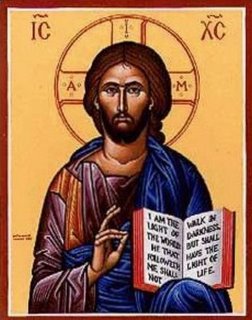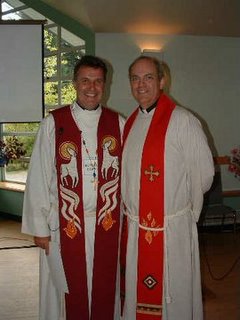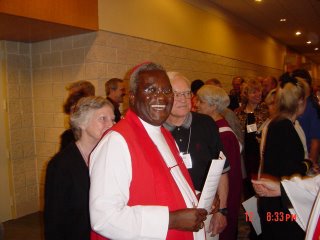Christian Beliefs about Healing
This Sunday at Five will be at the Bowlers' at 2087 Beaton Ave, Comox . We shall begin with the Eucharist, followed by potluck supper and then Cynthia will facilitate a discussion on a Christian understanding of healing.
1. What do we mean when we talk about different forms of illness? Give examples of Physical, Emotional, and Spiritual illnesses.
2. How do you feel when you are ill?
3. What makes it difficult to pray when you are ill?
4. How did Jesus go about healing those who were ill? Give some different examples.
Luke 5:12-16; 7:1-10; Luke 8:26-36; Luke 8:40-56. etc.
5. Jesus sent his disciples to do as He had done. He sends us today to be his instruments of healing. Our instructions are in James 5:14-15.
The Sacrament or sacramental rite of Unction, otherwise known as the anointing of the sick, is based on the James chapter five scripture. The priest lays hands on the person who has asked for prayer and then anoints their head and hands with consecrated oil. The priest or other Christians then pray for the person. Always as part of this there is opportunity for the person to accept Christ as Lord and Saviour.
6. What is happening when we pray for physical healing and the person does not get well?
7. If we acknowledge that this world is not our home and that our home is heaven what do you see as the perfect healing?
8. In your experience what does Jesus, through the Holy Spirit, always do when we pray for healing?
Saturday, January 28, 2006
Thursday, January 19, 2006
Confirming Our Faith: Life after Death and the Return of Christ.
Confirming Our Faith : Life after Death and the Return of Christ.
Part One: This Sunday evening we look at the very important topics of life after death and of Christ’s return. We should do so with a view to considering how living in the light of the Kingdom of God should influence our values, priorities and life-style on earth. We should not be preoccupied with speculation about the time-table of events but rather prepare for his coming, living each moment in anticipation of his return. Furthermore, Jesus’ resurrection overcame the power and fear of death.
Firstly, a few words about the Anglican approach to scripture and doctrine:
every doctrine that is necessary for salvation is found in Scripture – we do not insist that anyone believe a teaching that cannot be proven from Scripture.
no text in Scripture should be interpreted in a manner that is in conflict with the rest of the Bible – i.e. Scripture interprets Scripture.
longstanding traditions of the Church which are not contrary to Scripture continue to be held. We respect the teachings of the church fathers, councils and saints through the centuries, provided they do not contradict the clear teaching of scripture.
we are not inclined to accept innovative doctrines which are not part of the deposit of faith received from the Apostles and taught by the church of the first few centuries: this means we do not hold to either the additions of Rome (e.g. purgatory etc) or new revelations promoted by various sects and cults.
Old Testament teaching on life after death is sparse. Jews believed in Sheol, the place of the departed, variously translated in English as hell, the grave or the pit or abyss, and in Greek as Hades. The righteous and the unrighteous alike had the same destiny. Some OT scriptures imply life after death or a resurrection, eg Psalm 16:10, Job 19:25-27. Daniel 12: 2 and Isaiah 66:24 imply two destinies: for the good and the evil.
Inter-testamental Period: 2 Macabees 12:42-45 mentions prayers and sacrifices for the dead.
New Testament times:
The Sadducees denied the resurrection of the body and the existence of angels. The Pharisees accepted both as did Jesus. Jesus taught extensively on heaven, hell, the resurrection and judgment as well as his second coming. He also used a new name for hell: Gehenna which referred to the valley of Hinnom outside Jerusalem where worshippers of Moloch had sacrificed their children and which had been turned into a refuse dump. There fires burned constantly to consume garbage and the corpses of executed criminals. This provided an apt metaphor for eternal torment.
St Paul writes of the resurrection in 1 Cor 15 and also of the second coming of Jesus in his letters to the Thessalonians (1Thes 4 and 2Thes 2).
Summary:
The word “Heaven” is used in several different ways in the Bible: as the sky, as a euphemism for God, as the realm of God where he dwells with the angels and the saints, and as the final destination of the faithful.
The English word “Hell” is a translation of various different concepts which are not synonymous: the place of all the departed before Christ’s crucifixion (Sheol or Hades), the realm of Satan and his demons, or the final destiny of those who reject Christ. Furthermore, in Revelation we read of a lake of fire prepared for the devil and his angels, into which death and Hades will be thrown along with those who rebel against God. We do not know how much of the language used to describe these places or states is figurative and how much is literal.
Salvation is by faith in Christ, by Grace alone as a gift from God, and not as a reward for observing the Law.
Eternal punishment awaits those who reject Christ. Some Christians believe this is final annihilation, others that it is perpetual torment. Universalists believe that eventually all will be saved: this cannot be supported from scripture. The Eastern Orthodox have an interesting approach: they teach that those who have rejected Christ experience the eternal love of God as painful, whereas those who have accepted Christ experience it as wonderful.
Paradise appears to be that part of Sheol where the righteous awaited the resurrection. The righteous and the unrighteous souls were separated but aware of each other in Jesus’ parable of Lazarus and the rich man. There is therefore no contradiction in Jesus’ words to the repentant thief that “today you will be with me in Paradise” and the line in the Apostle’s Creed which states that Jesus descended to the dead (Hades, sometimes translated as Hell).
After Jesus’ death he preached to the people of the Old Testament era in Sheol/Hades and freed the righteous: 1 Peter 3:19-20, 1Peter 4:6, 2 Cor 2:14 and Eph 4:8-10. This is sometimes referred to in literature as the “harrowing of hell”. The OT saints were saved by looking forward to Christ just as we are saved by faith in his completed work on Calvary.
Our eternal destiny is determined before we die (particular judgment: Heb 9:27). When we die, if we have accepted salvation, although our bodies appear to sleep, our spirits are aware, and they are with Christ in heaven awaiting the resurrection of the body. The spirits of those who have rejected Christ await a resurrection to judgment.
The Church includes the faithful on earth and the souls of the faithful departed, who are in God’s presence now and are a “great cloud of witnesses” surrounding us. When we worship God we do so together with the all those faithful Christians who preceded us.
Before Christ returns the church will be persecuted from without and afflicted with heresy within. These have both been the experience of the church since the beginning but will be worse before he returns. Nevertheless, we have his promise that the Holy Spirit will guide the church into all truth and the church itself is referred to as the “pillar and ground of truth”. Therefore we can have confidence that there will still be a faithful church when he returns.
Christ will return in triumph as Lord and King to judge the earth. The dead in Christ will rise to meet him as he comes with his angels. (The first resurrection). His followers will have glorified bodies like his resurrected body.
The scriptures speak of 1000 year reign of Christ on earth assisted by the faithful. Some Christians believe this to represent the church age, others believe in a literal 1000 year reign, after which comes the final rebellion of Satan and Christ’s final victory. Among the early church fathers one can find both views represented.
There will be a new heaven and a new earth.
Satan, his angels and his followers will be cast into the Lake of Fire.
Part Two: Areas of controversy: there is not sufficient space here to deal with these in depth but we can discuss them.
Purgatory.
The Millenium.
The secret Rapture.
The fate of unbaptized babies who die.
The fate of those who have never heard the gospel.
Prayer to the saints
Prayers for the dead.
Part One: This Sunday evening we look at the very important topics of life after death and of Christ’s return. We should do so with a view to considering how living in the light of the Kingdom of God should influence our values, priorities and life-style on earth. We should not be preoccupied with speculation about the time-table of events but rather prepare for his coming, living each moment in anticipation of his return. Furthermore, Jesus’ resurrection overcame the power and fear of death.
Firstly, a few words about the Anglican approach to scripture and doctrine:
every doctrine that is necessary for salvation is found in Scripture – we do not insist that anyone believe a teaching that cannot be proven from Scripture.
no text in Scripture should be interpreted in a manner that is in conflict with the rest of the Bible – i.e. Scripture interprets Scripture.
longstanding traditions of the Church which are not contrary to Scripture continue to be held. We respect the teachings of the church fathers, councils and saints through the centuries, provided they do not contradict the clear teaching of scripture.
we are not inclined to accept innovative doctrines which are not part of the deposit of faith received from the Apostles and taught by the church of the first few centuries: this means we do not hold to either the additions of Rome (e.g. purgatory etc) or new revelations promoted by various sects and cults.
Old Testament teaching on life after death is sparse. Jews believed in Sheol, the place of the departed, variously translated in English as hell, the grave or the pit or abyss, and in Greek as Hades. The righteous and the unrighteous alike had the same destiny. Some OT scriptures imply life after death or a resurrection, eg Psalm 16:10, Job 19:25-27. Daniel 12: 2 and Isaiah 66:24 imply two destinies: for the good and the evil.
Inter-testamental Period: 2 Macabees 12:42-45 mentions prayers and sacrifices for the dead.
New Testament times:
The Sadducees denied the resurrection of the body and the existence of angels. The Pharisees accepted both as did Jesus. Jesus taught extensively on heaven, hell, the resurrection and judgment as well as his second coming. He also used a new name for hell: Gehenna which referred to the valley of Hinnom outside Jerusalem where worshippers of Moloch had sacrificed their children and which had been turned into a refuse dump. There fires burned constantly to consume garbage and the corpses of executed criminals. This provided an apt metaphor for eternal torment.
St Paul writes of the resurrection in 1 Cor 15 and also of the second coming of Jesus in his letters to the Thessalonians (1Thes 4 and 2Thes 2).
Summary:
The word “Heaven” is used in several different ways in the Bible: as the sky, as a euphemism for God, as the realm of God where he dwells with the angels and the saints, and as the final destination of the faithful.
The English word “Hell” is a translation of various different concepts which are not synonymous: the place of all the departed before Christ’s crucifixion (Sheol or Hades), the realm of Satan and his demons, or the final destiny of those who reject Christ. Furthermore, in Revelation we read of a lake of fire prepared for the devil and his angels, into which death and Hades will be thrown along with those who rebel against God. We do not know how much of the language used to describe these places or states is figurative and how much is literal.
Salvation is by faith in Christ, by Grace alone as a gift from God, and not as a reward for observing the Law.
Eternal punishment awaits those who reject Christ. Some Christians believe this is final annihilation, others that it is perpetual torment. Universalists believe that eventually all will be saved: this cannot be supported from scripture. The Eastern Orthodox have an interesting approach: they teach that those who have rejected Christ experience the eternal love of God as painful, whereas those who have accepted Christ experience it as wonderful.
Paradise appears to be that part of Sheol where the righteous awaited the resurrection. The righteous and the unrighteous souls were separated but aware of each other in Jesus’ parable of Lazarus and the rich man. There is therefore no contradiction in Jesus’ words to the repentant thief that “today you will be with me in Paradise” and the line in the Apostle’s Creed which states that Jesus descended to the dead (Hades, sometimes translated as Hell).
After Jesus’ death he preached to the people of the Old Testament era in Sheol/Hades and freed the righteous: 1 Peter 3:19-20, 1Peter 4:6, 2 Cor 2:14 and Eph 4:8-10. This is sometimes referred to in literature as the “harrowing of hell”. The OT saints were saved by looking forward to Christ just as we are saved by faith in his completed work on Calvary.
Our eternal destiny is determined before we die (particular judgment: Heb 9:27). When we die, if we have accepted salvation, although our bodies appear to sleep, our spirits are aware, and they are with Christ in heaven awaiting the resurrection of the body. The spirits of those who have rejected Christ await a resurrection to judgment.
The Church includes the faithful on earth and the souls of the faithful departed, who are in God’s presence now and are a “great cloud of witnesses” surrounding us. When we worship God we do so together with the all those faithful Christians who preceded us.
Before Christ returns the church will be persecuted from without and afflicted with heresy within. These have both been the experience of the church since the beginning but will be worse before he returns. Nevertheless, we have his promise that the Holy Spirit will guide the church into all truth and the church itself is referred to as the “pillar and ground of truth”. Therefore we can have confidence that there will still be a faithful church when he returns.
Christ will return in triumph as Lord and King to judge the earth. The dead in Christ will rise to meet him as he comes with his angels. (The first resurrection). His followers will have glorified bodies like his resurrected body.
The scriptures speak of 1000 year reign of Christ on earth assisted by the faithful. Some Christians believe this to represent the church age, others believe in a literal 1000 year reign, after which comes the final rebellion of Satan and Christ’s final victory. Among the early church fathers one can find both views represented.
There will be a new heaven and a new earth.
Satan, his angels and his followers will be cast into the Lake of Fire.
Part Two: Areas of controversy: there is not sufficient space here to deal with these in depth but we can discuss them.
Purgatory.
The Millenium.
The secret Rapture.
The fate of unbaptized babies who die.
The fate of those who have never heard the gospel.
Prayer to the saints
Prayers for the dead.
Saturday, January 14, 2006
Sunday At Five January 15th.
Sunday at Five is at 2087 Beaton Ave, Comox. Tel 339-4799
Holy Communion at 5 pm
Potluck Supper at 6pm
Discussion at 7pm.
Holy Communion at 5 pm
Potluck Supper at 6pm
Discussion at 7pm.
The Anglican Coalition in Canada Moves Forward
The Anglican Coalition in Canada Moves Forward
The ACiC (Anglican Coalition in Canada) is pleased to report that the Adequate Episcopal Oversight given by an alliance of five global south Primates is no longer temporary. The ACiC (Anglican Communion in Canada) has been officially renamed the “Anglican Coalition in Canada” because the original name had been challenged by the Anglican Church of Canada (ACC).
The link between the ACiC and the AMiA (Anglican Mission in America) continues with the result that the ACiC is one of the AMiA’s networks in North America. Like the Anglican Mission, the ACiC clergy and congregations are licensed directly by Archbishop Emmanuel Kolini as a missionary outreach of the Episcopal Province of Rwanda. Direct oversight is provided by Bishop Thomas (TJ) Johnston, a missionary bishop of the Province of Rwanda and the Anglican Mission, with the Rev. Paul Carter serving as Network Leader.
A video presentation of the ACiC story is available online at http://acicanada.ca/documents/acic.ram. For information on possible affiliation, please click on http://acicanada.ca/affiliate.
A small CD introducing the work of the ACiC is available free of charge and newly released DVD’s of talks from Bishop Johnston sharing the vision, passion and DNA of the ACiC are available on request. The ACiC is committed to evangelism, church health and church planting.
For further information about the Anglican Coalition in Canada, please contact the Rev. Paul Carter, ACiC Network Leader at paul@acicanada.ca or (604) 222-4486 or The Rev. Ed Hird, ACiC Communications Leader at ed_hird@telus.net or (604) 929-5350.
The ACiC (Anglican Coalition in Canada) is pleased to report that the Adequate Episcopal Oversight given by an alliance of five global south Primates is no longer temporary. The ACiC (Anglican Communion in Canada) has been officially renamed the “Anglican Coalition in Canada” because the original name had been challenged by the Anglican Church of Canada (ACC).
The link between the ACiC and the AMiA (Anglican Mission in America) continues with the result that the ACiC is one of the AMiA’s networks in North America. Like the Anglican Mission, the ACiC clergy and congregations are licensed directly by Archbishop Emmanuel Kolini as a missionary outreach of the Episcopal Province of Rwanda. Direct oversight is provided by Bishop Thomas (TJ) Johnston, a missionary bishop of the Province of Rwanda and the Anglican Mission, with the Rev. Paul Carter serving as Network Leader.
A video presentation of the ACiC story is available online at http://acicanada.ca/documents/acic.ram. For information on possible affiliation, please click on http://acicanada.ca/affiliate.
A small CD introducing the work of the ACiC is available free of charge and newly released DVD’s of talks from Bishop Johnston sharing the vision, passion and DNA of the ACiC are available on request. The ACiC is committed to evangelism, church health and church planting.
For further information about the Anglican Coalition in Canada, please contact the Rev. Paul Carter, ACiC Network Leader at paul@acicanada.ca or (604) 222-4486 or The Rev. Ed Hird, ACiC Communications Leader at ed_hird@telus.net or (604) 929-5350.
Saturday, January 07, 2006
First Sunday after Epiphany: The Baptism of our Lord
Sunday 8th is the first Sunday after Epiphany. 6 January is the 12th day of Christmas, the day when the church celebrates the revelation of God in Christ to the Gentiles, in paticular, the three Magi. The first Sunday after Epiphany celebrates Christ's Baptism at which time the Holy Spirit descended upon him and his Heavenly Father declared "You are my beloved Son, and I am fully pleased with you." Jesus is revealed as the eternal Son of God, God's beloved anointed servant.
Sunday at Five, January 8th, 2006
Sunday at Five is at the Bowlers. Eucharist at five pm, supper at 6pm followed by a discussion on Christian Leadership and the purpose/meaning of ordination.
Ministry of the Whole People of God:
The concept of the laity (as non-experts) as distinct from the clergy (religious experts) is foreign to the New Testament. The closest to it is the term laos which refers to the whole people of God, the church or the body of Christ. The functions of oversight (episcope), leading in the service of God (leitourgia, from which we get the word liturgy) and service to neighbour (diakonia) are exercised within the laos and are epitomized by, but not limited to, the orders of bishops, presbyters and deacons. Parents, Sunday School teachers and youth workers exercise episcope in their respective fields. Readers and worship leaders and indeed the whole congregation participate in the liturgy (the “work of the people”). Anyone who serves another is practicing diakonia.
As Anglicans we often conceptualize the three orders as a pyramidal hierarchy with a fixed barrier between laity and clergy. It would be better to think of four orders in a series of concentric circles the largest being the laos. Within the church some are called to be deacons. Some deacons are ordained to be presbyters, and within the college of presbyters some (usually one in each location or diocese) are called to exercise Episcopal oversight as pastors of the pastors. One becomes a member of the church through faith, repentance, baptism and receiving the Spirit. The laity are commissioned for service through Baptism followed by the laying on of hands and invocation of the seven-fold Spirit at Confirmation. The other three orders are ordained similarly. Each sequential order includes the preceding one so that a deacon does not cease to be a member of God’s people when he is made deacon, a presbyter does not cease to serve and a bishop is still a priest.
The gifts of the Spirit are given for the benefit of the whole church. The five-fold ministry of apostles, prophets, pastors, teachers and evangelists exists to equip the saints (i.e. all Christians) for the work of the ministry. In South East Asia, for example, great store is laid on lay leadership. Lay evangelists and church-planters are sent out and their work is later followed up by clergy. Potential pastors are trained on the job and are sent to seminary later rather than before initiating their ministry.
People who sense a call to ordained ministry have to have demonstrated gifting and fruit-bearing in a lay capacity before the process of postulant selection begins. This process will need to be owned by and signed off by a local church who also sense giftedness and would endorse their application.
Readings:
Five-fold ministry: Ephesians 4:11-12
Apostles were the first overseers of the church: John 15:16. Acts 1:26
Ordain means to appoint by laying on hands: Greek: Kathistemi or cheirotoneo (Acts 14:23), 1 Timothy 1:6. This is accompanied by prayer and the invocation of the Holy Spirit.
Presbyter =priest =elder, Deacon=servant, Bishop=shepherd or overseer
Deacons: Acts 6:1-6, 1 Timothy 3:8-13, Woman deacon: Romans 16:1, 1 Tim 3:11
Presbyters: Acts 14:23, 1 Timothy 4:14, 1 Timothy 5: 17 &22
Titus 1:5-7
Bishops: 1Timothy 3:1-12
See also: Philippians 1:1
Questions: 1. What are the differences between the Old Testament priest and a Christian presbyter? 2. Who is our great high priest? Hebrews 7-8. 3.What do people mean by ”the priesthood of all believers”? Ex 19:6, 1Peter 2:5. 1Peter 2:9, Rev 1:6, Rev 20:6
3. What did Jesus teach about leadership? John 13:1-17, Luke 22:24-27
Ministry of the Whole People of God:
The concept of the laity (as non-experts) as distinct from the clergy (religious experts) is foreign to the New Testament. The closest to it is the term laos which refers to the whole people of God, the church or the body of Christ. The functions of oversight (episcope), leading in the service of God (leitourgia, from which we get the word liturgy) and service to neighbour (diakonia) are exercised within the laos and are epitomized by, but not limited to, the orders of bishops, presbyters and deacons. Parents, Sunday School teachers and youth workers exercise episcope in their respective fields. Readers and worship leaders and indeed the whole congregation participate in the liturgy (the “work of the people”). Anyone who serves another is practicing diakonia.
As Anglicans we often conceptualize the three orders as a pyramidal hierarchy with a fixed barrier between laity and clergy. It would be better to think of four orders in a series of concentric circles the largest being the laos. Within the church some are called to be deacons. Some deacons are ordained to be presbyters, and within the college of presbyters some (usually one in each location or diocese) are called to exercise Episcopal oversight as pastors of the pastors. One becomes a member of the church through faith, repentance, baptism and receiving the Spirit. The laity are commissioned for service through Baptism followed by the laying on of hands and invocation of the seven-fold Spirit at Confirmation. The other three orders are ordained similarly. Each sequential order includes the preceding one so that a deacon does not cease to be a member of God’s people when he is made deacon, a presbyter does not cease to serve and a bishop is still a priest.
The gifts of the Spirit are given for the benefit of the whole church. The five-fold ministry of apostles, prophets, pastors, teachers and evangelists exists to equip the saints (i.e. all Christians) for the work of the ministry. In South East Asia, for example, great store is laid on lay leadership. Lay evangelists and church-planters are sent out and their work is later followed up by clergy. Potential pastors are trained on the job and are sent to seminary later rather than before initiating their ministry.
People who sense a call to ordained ministry have to have demonstrated gifting and fruit-bearing in a lay capacity before the process of postulant selection begins. This process will need to be owned by and signed off by a local church who also sense giftedness and would endorse their application.
Readings:
Five-fold ministry: Ephesians 4:11-12
Apostles were the first overseers of the church: John 15:16. Acts 1:26
Ordain means to appoint by laying on hands: Greek: Kathistemi or cheirotoneo (Acts 14:23), 1 Timothy 1:6. This is accompanied by prayer and the invocation of the Holy Spirit.
Presbyter =priest =elder, Deacon=servant, Bishop=shepherd or overseer
Deacons: Acts 6:1-6, 1 Timothy 3:8-13, Woman deacon: Romans 16:1, 1 Tim 3:11
Presbyters: Acts 14:23, 1 Timothy 4:14, 1 Timothy 5: 17 &22
Titus 1:5-7
Bishops: 1Timothy 3:1-12
See also: Philippians 1:1
Questions: 1. What are the differences between the Old Testament priest and a Christian presbyter? 2. Who is our great high priest? Hebrews 7-8. 3.What do people mean by ”the priesthood of all believers”? Ex 19:6, 1Peter 2:5. 1Peter 2:9, Rev 1:6, Rev 20:6
3. What did Jesus teach about leadership? John 13:1-17, Luke 22:24-27
Monday, January 02, 2006
Bishop "TJ" Johnston
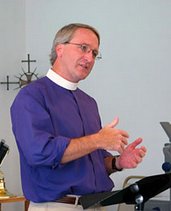 Bishop TJ, a missionary bishop of the Episcopal Church of Rwanda, has been delegated the task of overseeing the ACiC.
Bishop TJ, a missionary bishop of the Episcopal Church of Rwanda, has been delegated the task of overseeing the ACiC. 
Archbishop Yong Ping Chung
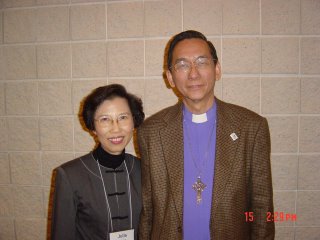 Archbishop Yong, Primate of South East Asia, and his wife Julia have a long history of contact with Canadian Anglicans, especially in Newfoundland. Archbishop Yong chairs the group of AnglicanPrimates who provide oversight to Church of Our Lord and our sister churches of the ACiC.
Archbishop Yong, Primate of South East Asia, and his wife Julia have a long history of contact with Canadian Anglicans, especially in Newfoundland. Archbishop Yong chairs the group of AnglicanPrimates who provide oversight to Church of Our Lord and our sister churches of the ACiC. 
Archbishop Kolini with Father Silas Ng
Archbishop Kolini is Primate of the Episcopal Church of Rwanda.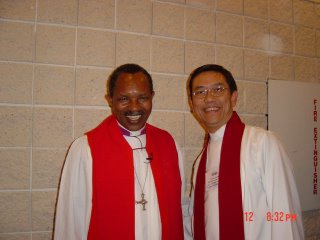 Fr Silas is rector of Richmond Emmanuel Church in Richmond , BC.
Fr Silas is rector of Richmond Emmanuel Church in Richmond , BC. 
All ACiC clergy are licenced and canonically resident in the Anglican Province of Rwanda. (L'Eglise Episcopal au Rwanda)
 Fr Silas is rector of Richmond Emmanuel Church in Richmond , BC.
Fr Silas is rector of Richmond Emmanuel Church in Richmond , BC. 
All ACiC clergy are licenced and canonically resident in the Anglican Province of Rwanda. (L'Eglise Episcopal au Rwanda)
Subscribe to:
Posts (Atom)

